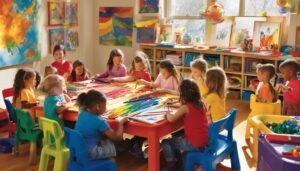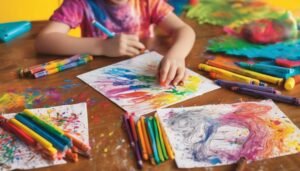Studies show that engaging in coloring can improve fine motor skills by up to 30% in young children. As kids pick up crayons and fill in shapes, they’re not just having fun; they’re developing essential skills for future tasks like writing. But there’s more to coloring than just motor development. It also plays a crucial role in cognitive growth and emotional expression, which can significantly impact a child’s overall development. What other benefits might you discover?
Key Takeaways
- Coloring enhances fine motor skills, improving dexterity and coordination vital for tasks like writing and buttoning clothes.
- It boosts hand-eye coordination by fostering precise movement control and spatial awareness through navigating within lines.
- Engaging in coloring stimulates cognitive growth, encouraging critical thinking and memory retention through color choices and emotional connections.
- Coloring activities promote color recognition and shape identification, reinforcing understanding of color theory and spatial relationships.
- It encourages emotional expression, allowing children to communicate feelings creatively and reduce stress through artistic engagement.
Enhancing Fine Motor Skills
Coloring can significantly boost your child’s fine motor skills, making it both a fun and beneficial activity. As your child explores different coloring techniques, like shading and blending, they’re honing their hand movements.
Using various art materials, such as crayons, markers, or colored pencils, forces your child to grasp, press, and control these tools, enhancing dexterity. Each stroke they make develops coordination and strength in their fingers and hands, crucial for later tasks like writing and buttoning clothes.
Improving Hand-Eye Coordination
One of the surprising benefits of coloring is its ability to improve hand-eye coordination. When you encourage your child to use various coloring techniques, like shading or blending colors, they learn to control their movements more precisely.
This practice enhances spatial awareness, as they become adept at recognizing where their hands need to be in relation to the page. As your child navigates within the lines and experiments with different strokes, they develop a better understanding of visual cues and coordination.
This skill is crucial not just for coloring, but also for writing, sports, and everyday tasks. So, when your child picks up those crayons, remember, they’re not just creating art—they’re honing essential coordination skills!
Fostering Cognitive Growth
While honing hand-eye coordination, kids also engage in activities that stimulate their cognitive development. As they choose colors for their drawings, they’re not just being creative; they’re exploring color theory, which enhances their understanding of relationships and contrasts.
This process encourages critical thinking as they make decisions about which colors to use and where to apply them. Additionally, coloring can boost memory retention. Research shows that when children connect colors with emotions or stories, they improve their ability to recall information.
Engaging in these activities helps develop problem-solving skills, as kids learn to navigate the challenges of shading and blending. Overall, coloring serves as a powerful tool for fostering cognitive growth in young minds.
Building Knowledge of Colors and Shapes
As children immerse themselves in coloring activities, they naturally begin to build their knowledge of colors and shapes. This hands-on approach promotes color recognition and shape identification, essential for early childhood development. When kids choose colors for their drawings, they enhance their understanding of color theory and spatial awareness.
| Color | Shape | Example |
|---|---|---|
| Red | Circle | Apple |
| Blue | Square | Window |
| Green | Triangle | Tree |
| Yellow | Rectangle | Book |
| Purple | Oval | Balloon |
Encouraging Emotional Expression
Coloring provides a powerful outlet for children to express their emotions and feelings. When kids pick up crayons or markers, they often channel their inner thoughts, allowing for an emotional release that can be therapeutic.
Research shows that engaging in creative activities like coloring can significantly reduce stress levels, helping children cope with anxiety and frustration. As they choose colors and create their own worlds, they also gain the ability to communicate feelings that might be difficult to articulate verbally.
This simple activity not only nurtures emotional well-being but also empowers kids to explore and understand their emotions better.
Boosting Creativity and Imagination
When kids color, they get to explore a world of color choices that can spark their creativity.
By mixing and matching hues or creating unique designs, they express their individuality and imagination.
This hands-on experience not only enhances their artistic skills but also encourages innovative thinking that can benefit them in various aspects of life.
Enhancing Color Choices
While exploring the world of colors, kids can unlock a realm of creativity and imagination that fuels their artistic development. By experimenting with different shades and tones, they learn about color theory and how colors can express emotions and ideas.
This not only enhances their understanding of color symbolism but also encourages more thoughtful color choices in their artwork.
- Kids can mix colors to create unique shades, deepening their understanding of color relationships.
- They learn to associate colors with feelings, enhancing emotional expression in their art.
- Exploring various palettes strengthens their decision-making skills, fostering confidence in artistic choices.
Encouraging kids to play with colors boosts their creativity and nurtures their ability to visualize and communicate through art.
Encouraging Unique Designs
Encouraging kids to create unique designs not only sparks their imagination but also builds their problem-solving skills. When children engage in design exploration, they learn to interpret colors in ways that reflect their personalities.
This process fosters a sense of ownership over their creations, allowing them to experiment with different color interpretations and styles. As they explore various patterns and themes, kids enhance their creative thinking and develop a keen sense of aesthetics.
Moreover, this playful activity encourages them to think critically about their choices and the impact of color on their designs. By nurturing their ability to create original artwork, you empower them to express themselves confidently and cultivate lifelong creative skills.
Supporting Focus and Concentration
Coloring can significantly enhance your child’s ability to focus and concentrate, as it requires sustained attention to detail and creativity. This engaging activity serves as a mindfulness practice, promoting awareness and presence in the moment. By immersing themselves in coloring, kids can effectively boost their attention span while developing fine motor skills.
- It encourages patience as they work on intricate designs.
- The repetitive motions can calm an active mind, fostering relaxation.
- Coloring allows for self-expression, which can lead to increased engagement.
Incorporating coloring sessions into your child’s routine can contribute to better focus and concentration in other areas of learning, making it a valuable tool in their educational journey.
Frequently Asked Questions
At What Age Should Kids Start Coloring?
Kids typically start coloring around 18 months, hitting important coloring milestones as they progress through developmental stages. By age three, they’ll begin to show more control and creativity with their coloring tools, enhancing their skills.
How Can Coloring Help With Anxiety in Children?
Studies show that 75% of children experience anxiety. By using mindful coloring techniques, you can help them calm their minds, improve focus, and express emotions, making coloring an effective tool for managing anxiety in kids.
What Materials Are Best for Children to Color With?
For children, vibrant crayons like wax or twist-up types work well, providing smooth coloring experiences. Pair them with fun, age-appropriate coloring books, featuring their favorite characters, to keep them engaged and excited about creating art.
How Can Parents Encourage Coloring at Home?
To encourage coloring at home, establish daily coloring routines in dedicated creative spaces, like a cozy nook with art supplies. For instance, setting up a colorful table can inspire your child’s imagination and creativity.
Are There Any Digital Coloring Apps for Kids?
Yes, there are great digital coloring apps for kids! Look for app features like interactive designs, a variety of colors, and fun animations. These can make coloring engaging and enhance creativity in your child’s digital experience.
Conclusion
In a world bursting with colors, coloring serves as a vibrant canvas for your child’s development. By enhancing fine motor skills and hand-eye coordination, it lays the groundwork for future writing. As they explore hues and shapes, cognitive growth flourishes, while emotional expression flows freely through each stroke. So, pick up those crayons and watch as your little artist’s creativity blossoms, turning simple pages into a kaleidoscope of imagination, focus, and joy.




